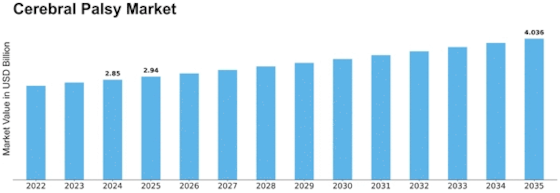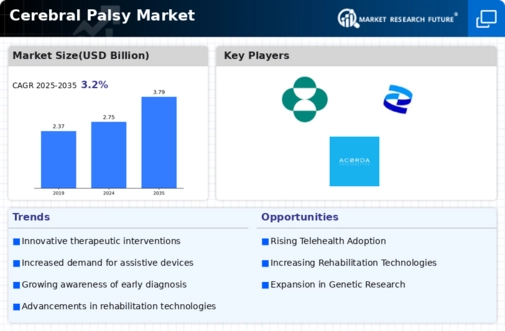Cerebral Palsy Size
Cerebral Palsy Market Growth Projections and Opportunities
The market for Cerebral Palsy (CP) includes a range of healthcare, medical, and assistive therapies that aim to meet the special requirements of people with such neurological conditions. One key focus in the Cerebral Palsy market is on medications and treatments designed to manage symptoms and improve functionality. Physical therapy has an important role here in enhancing motor skills and coordination as well as improving general physical health. Occupational therapy can help with daily activities, including adaptive techniques and fine motor skills, while speech therapy targets communication difficulties experienced by people living with CP. Some drugs like muscle relaxants or antispastics are sometimes prescribed in order to manage specific symptoms arising from this condition. The market dynamics will be affected by ongoing research efforts aimed at developing innovative medical interventions and perfecting existing ones so as to achieve optimal results for individuals living with CP. Cerebral palsy's orthopedic interventions also count towards another segment of the market, especially for those having musculoskeletal complications. Orthopedic surgeries such as muscle or tendon lengthening procedures may be considered in order to enhance joint function and alleviate pain. With regard to cerebral palsy, mobility aids include powered wheelchairs or exoskeletons, which allow greater independence and involvement in various activities. This sector has seen significant improvements through technological advancements and continuous innovations in assistive technologies that are tailored toward addressing the different needs of people living with cerebral palsy. Apart from medical interventions, there is a need for early intervention support systems, considering these children have special needs, too, due to their suffering from cerebral palsy. As far as early childhood programs are concerned, developmental therapies and educational initiatives seek not only to maximize this child's potential but also to ensure they attain full growth and development optimally. Within the Cerebral Palsy marketplace exists mental health support, which acknowledges the psychological challenges encountered by anyone suffering from it, both physically & emotionally speaking. Consequently, challenges facing the market of cerebral palsy include the need for improved access to specialized care, especially in underserved areas. To overcome these challenges, it is important to address disparities in health resources and encourage early diagnosis and intervention. Furthermore, ongoing research is being carried out with a view of demystifying cerebral palsy so as to establish possible genetic, environmental, and therapeutic factors that can affect it.










Leave a Comment